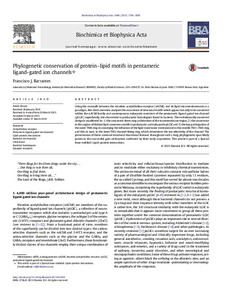Por favor, use este identificador para citar o enlazar este ítem:
https://repositorio.uca.edu.ar/handle/123456789/8736| Campo DC | Valor | Lengua/Idioma |
|---|---|---|
| dc.contributor.author | Barrantes, Francisco José | es |
| dc.date.accessioned | 2019-09-13T15:17:33Z | - |
| dc.date.available | 2019-09-13T15:17:33Z | - |
| dc.date.issued | 2015 | - |
| dc.identifier.citation | Barrantes FJ. Phylogenetic conservation of protein–lipid motifs in pentameric ligand-gated ion channels. Biochimica et Biophysica Acta. 2015; 1848. https://doi.org/10.1016/j.bbamem.2015.03.028. Disponible en: https://repositorio.uca.edu.ar/handle/123456789/8736 | es |
| dc.identifier.issn | 0006-3002 | - |
| dc.identifier.uri | https://repositorio.uca.edu.ar/handle/123456789/8736 | - |
| dc.description.abstract | Abstract: Using the crosstalk between the nicotinic acetylcholine receptor (nAChR) and its lipid microenvironment as a paradigm, this short overviewanalyzes the occurrence of structuralmotifswhich appear not only to be conserved within the nAChR family and contemporary eukaryotic members of the pentameric ligand-gated ion channel (pLGIC) superfamily, but also extend to prokaryotic homologues found in bacteria. The evolutionarily conserved design ismanifested in: 1) the concentric three-ring architecture of the transmembrane region, 2) the occurrence in this region of distinct lipid consensusmotifs in prokaryotic and eukaryotic pLGIC and 3) the key participation of the outer TM4 ring in conveying the influence of the lipidmembrane environment to themiddle TM1–TM3 ring and this, in turn, to the inner TM2 channel-lining ring, which determines the ion selectivity of the channel. The preservation of these constant structural–functional features throughout such a long phylogenetic span likely points to the successful gain-of-function conferred by their early acquisition. This article is part of a Special Issue entitled: Lipid–protein interactions. | es |
| dc.format | application/pdf | es |
| dc.language.iso | eng | es |
| dc.publisher | Elsevier B.V. | es |
| dc.rights | Acceso abierto | * |
| dc.rights.uri | http://creativecommons.org/licenses/by-nc-sa/4.0/ | * |
| dc.source | Biochimica et Biophysica Acta n° 1848, 2015 | es |
| dc.subject | MEDICINA | es |
| dc.subject | RECEPTORES | es |
| dc.subject | PROTEINAS | es |
| dc.subject | LIPIDOS | es |
| dc.subject | CANALES IONICOS | es |
| dc.subject | COLESTEROL | es |
| dc.title | Phylogenetic conservation of protein–lipid motifs in pentameric ligand-gated ion channels | es |
| dc.type | Artículo | es |
| dc.identifier.doi | 10.1016/j.bbamem.2015.03.028 | - |
| uca.disciplina | MEDICINA | es |
| uca.issnrd | 1 | es |
| uca.affiliation | Fil: Barrantes, Francisco José. Pontificia Universidad Católica Argentina. Facultad de Ciencias Médicas. Instituto de Investigaciones Biomédicas. Laboratorio de Neurobiología Molecular; Argentina | es |
| uca.affiliation | Fil: Barrantes, Francisco José. Consejo Nacional de Investigaciones Científicas y Técnicas; Argentina | es |
| uca.version | publishedVersion | es |
| item.languageiso639-1 | en | - |
| item.fulltext | With Fulltext | - |
| item.grantfulltext | open | - |
| crisitem.author.dept | Instituto de Investigaciones Biomédicas - BIOMED | - |
| crisitem.author.dept | Laboratorio de Neurobiología Molecular | - |
| crisitem.author.dept | Facultad de Ciencias Médicas | - |
| crisitem.author.orcid | 0000-0002-4745-681X | - |
| crisitem.author.parentorg | Facultad de Ciencias Médicas | - |
| crisitem.author.parentorg | Instituto de Investigaciones Biomédicas - BIOMED | - |
| crisitem.author.parentorg | Pontificia Universidad Católica Argentina | - |
| Aparece en las colecciones: | Artículos | |
Ficheros en este ítem:
| Fichero | Descripción | Tamaño | Formato | |
|---|---|---|---|---|
| phylogenetic-conservation-protein-lipid.pdf | 1,3 MB | Adobe PDF |  Visualizar/Abrir |
Visualizaciones de página(s)
255
comprobado en 14-nov-2025
Descarga(s)
209
comprobado en 14-nov-2025
Google ScholarTM
Ver en Google Scholar
Altmetric
Altmetric
Este ítem está sujeto a una Licencia Creative Commons

